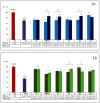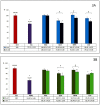The Antiglycoxidative Ability of Selected Phenolic Compounds-An In Vitro Study
- PMID: 31344905
- PMCID: PMC6696369
- DOI: 10.3390/molecules24152689
The Antiglycoxidative Ability of Selected Phenolic Compounds-An In Vitro Study
Abstract
Hyperglycemia and oxidative stress may be observed in different diseases as important factors connected with their development. They often occur simultaneously and are considered together as one process: Glycoxidation. This can influence the function or structure of many macromolecules, for example albumin, by changing their physiological properties. This disturbs the homeostasis of the organism, so the search for natural compounds able to inhibit the glycoxidation process is a current and important issue. The aim of this study was the examination of the antiglycoxidative capacity of 16 selected phenolic compounds, belonging to three phenolic groups, as potential therapeutic agents. Their antiglycoxidative ability, in two concentrations (2 and 20 µM), were examined by in vitro study. The inhibition of the formation of both glycoxidative products (advanced glycation end products (AGEs) and advanced oxidation protein products (AOPPs)) were assayed. Stronger antiglycoxidative action toward the formation of both AOPPs and AGEs was observed for homoprotocatechuic and ferulic acids in lower concentrations, as well as catechin, quercetin, and 8-O-methylurolithin A in higher concentrations. Homoprotocatechuic acid demonstrated the highest antiglycoxidative capacity in both examined concentrations and amongst all of them. A strong, significant correlation between the percentage of AOPPs and AGEs inhibition by compounds from all phenolic groups, in both examined concentrations, was observed. The obtained results give an insight into the antiglycoxidative potential of phenolic compounds and indicate homoprotocatechuic acid to be the most promising antiglycoxidative agent, but further biological and pharmacological studies are needed.
Keywords: AGEs; AOPPs; antiglycoxidative potential; glycoxidation; phenolic compounds.
Conflict of interest statement
The authors declare no conflict of interest.
Figures






Similar articles
-
Antiglycoxidative Properties of Extracts and Fractions from Reynoutria Rhizomes.Nutrients. 2021 Nov 14;13(11):4066. doi: 10.3390/nu13114066. Nutrients. 2021. PMID: 34836321 Free PMC article.
-
New knowledge on the antiglycoxidative mechanism of chlorogenic acid.Food Funct. 2015 Jun;6(6):2081-90. doi: 10.1039/c5fo00194c. Food Funct. 2015. PMID: 26037734
-
Antiglycoxidative properties of amantadine - a systematic review and comprehensive in vitro study.J Enzyme Inhib Med Chem. 2023 Dec;38(1):138-155. doi: 10.1080/14756366.2022.2137161. J Enzyme Inhib Med Chem. 2023. PMID: 36325591 Free PMC article.
-
Phenolics as potential antioxidant therapeutic agents: mechanism and actions.Mutat Res. 2005 Nov 11;579(1-2):200-13. doi: 10.1016/j.mrfmmm.2005.03.023. Epub 2005 Aug 26. Mutat Res. 2005. PMID: 16126236
-
Biochemical and Biophysical in Vitro Studies and Systematic Literature Review on the Antioxidant and Antiglycation Activities of Trazodone.Cell Physiol Biochem. 2023 Mar 29;57(2):82-104. doi: 10.33594/000000617. Cell Physiol Biochem. 2023. PMID: 36988041
Cited by
-
Investigation of the Phytochemical Composition, Antioxidant Activity, and Methylglyoxal Trapping Effect of Galega officinalis L. Herb In Vitro.Molecules. 2020 Dec 9;25(24):5810. doi: 10.3390/molecules25245810. Molecules. 2020. PMID: 33317096 Free PMC article.
-
Effects of Water-Ethanol Extracts from Four Sphagnum Species on Gene Expression of Selected Enzymes in Normal Human Dermal Fibroblasts and Their Antioxidant Properties.Pharmaceuticals (Basel). 2023 Jul 28;16(8):1076. doi: 10.3390/ph16081076. Pharmaceuticals (Basel). 2023. PMID: 37630991 Free PMC article.
-
Neuroprotective Effect of White Nelumbo nucifera Gaertn. Petal Tea in Rats Poisoned with Mancozeb.Foods. 2023 May 28;12(11):2175. doi: 10.3390/foods12112175. Foods. 2023. PMID: 37297420 Free PMC article.
-
Antioxidant and Antiglycation Effects of Cistus × incanus Water Infusion, Its Phenolic Components, and Respective Metabolites.Molecules. 2022 Apr 9;27(8):2432. doi: 10.3390/molecules27082432. Molecules. 2022. PMID: 35458630 Free PMC article.
-
Going "Green" in the Prevention and Management of Atherothrombotic Diseases: The Role of Dietary Polyphenols.J Clin Med. 2021 Apr 3;10(7):1490. doi: 10.3390/jcm10071490. J Clin Med. 2021. PMID: 33916712 Free PMC article. Review.
References
MeSH terms
Substances
Grants and funding
LinkOut - more resources
Full Text Sources
Medical

